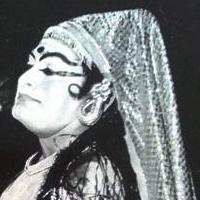Maya Tangeberg Grischin

June 8, 2011
My first experience with Kathakali was in Stockholm in 1974. I was then a angry young theatre director and performer of physical theatre, rejecting the European psychologiical, “realist” theatre conditioned by Rotowski and Barba! I considered Kathakali as highly energic, techniical, exotic and even mystic. I got very impressed with Kathakali in Stockholm. What a fantastic display of rhythm, movement and colours! The dancers seem to stamp all energy out from the earth, transform it in the base of the spine through round movements around its axe, and then lead it into arms and hands and spend it through action. The mime part – especially the mudras where inaccessible, but beautiful orrnaments. Gods, heroes and villains from mythology. There was that perfect Sita, too. A set of symbols of womanhood of another culture than mine and I lacked the keys to it.
In search of Kathakali
Since ’80, I have been visiting Kerala in search of the keys of Kathakali. By watching classes, and performances of Kathakali found very many interesting aspects useful for training western actors, too. But my interest centered round more at the physical level. I was not espeecially interested to learn a new sign language, who in anyway would not communicate back home.
The Discovery of Sita
My attitude towards Kathakali changed in ’81, when I for the first time watched Shivaraman perform Sita in Lavanasuravadham. Sita, as the symbol of womanhood, still haunting the Indian mind, but so far from today’s life and realities!! Shivaraman does not only depict. The traditional character of Sita, he re-thinks; interprets Sita and exammines the human substance behind the myth. He does not only show Sita’s emotions, but also the subtlest motives which lead to these emotions, and also the results of these emotions! For the first time, I was able to savor poetic and the dramatic aspect of Kathakali fully. Since then, I have seen Shivaraman perform many times. He is one of the few actors in the world, who are able to give expression for the fleetest of thoughts, the smallest of emotions. He gives a unbroken chain of the inner life of the character, the growth of emotion, its raise to a peak and the tuning down and the transformation of one fleeting emotion into another, also giving its motives, aims and results. Western actors try to do this, got nearly no one (except Chaplin and Marcel Marceau) years ago have the typical technique to express it, to make emotion to commmunicate. Often emotions would only stay inside the actor at not be visible, like a submarine. Most of European actors could learn a lot from Shivaraman!
Dancer: on the edge of the knife
What I especially like in Shivaraman’s performance, is his gracious walk on the edge of the knife – this sublime mixture of technique and spontaneity. Performances may differ one from annother, but he becomes never, never mechanical. To become mechaniical seems to me a very big danger for Kathakali performers, with a techhnique, where nearly everything is fixed by tradition, emotions may easily be produced on the surface, with the muscles of the face and the eyes only. Mechanical is also the “dwelling in the thing others have done since long time” and not to question it in performance. Shivaraman questions and explores the infrastructure of the set characcters.
Spontaneous knowled womanhood
Shivaraman is able to dive into the depths of womanhood, when performs female characters, transforming himself physically and mentally. May be it is true what C.O. Jung says, at all people have a part of the opposite sex. In their mind, it is only to accept it and to listen to “that other” too. Shivaraman is really able to portray real women. But, we always see behind the female, a man with wrinkles, who transforms fully into a pretty young girl! That is the magic and the erotic excitements of Kathakali at its best.
When Kathakali becomes commmunicative to modern man
The best quality of Shivaraman’s acting: It is highly communicative and touching. For making traditiona! communicative symbols, Kathakali actors need an infrastruccture of understandable signs as keys fortoday’s people in a modern world. Is it not the task of every actor, in Kathakali and modern drama as well, to rediscover the thought process, the actions and emotions of the character in performance?
Shivaraman is one of the rare artists who have opened Kathakali up and revealed its human qualities. He is able to load also the mudras, his hands with emotions, and many times I have admired the delicacy of a step, of a simple hand movement. At times more female than women themselves, there is no danger of a realistic picture when Shivaraman performs, and he so holds up a graceful mirror of womanhood, eastern and western, of yesterday and today.
I wish the artist many happy and healthy years. Let us enjoy his briliant and touching performances for a long time.
(From the book “mukharaagam” published by Kunchu Nair Trust for Kottakal Sivaraman’s 60th birthday. Year 1996)
0 Comments